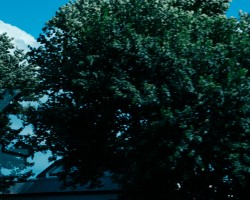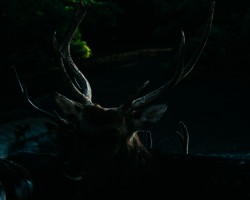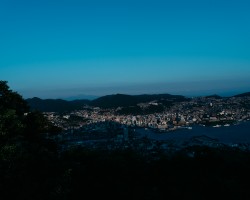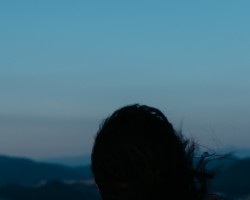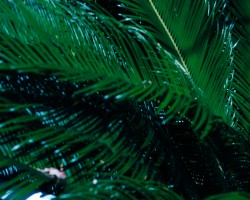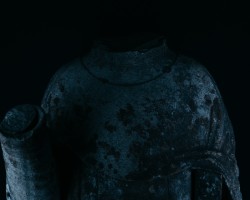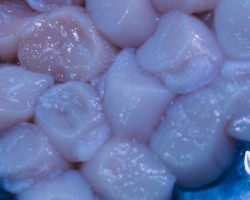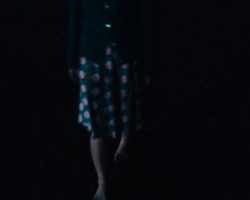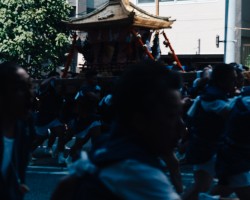Ground
August 8 th, 1945 . Two days after the atomic bomb was dropped on Hiroshima, a statement made by Dr Harold Jacobson, a scientist involved in the Manhattan Project, was published in an article by the Washington Post. Jacobson claimed that nothing would grow on the atomic- bombed land of Hiroshima for 75 years. Shortly after this, the scientist retracted the statement. Yet at the end of the same month, various Japanese newspapers reported the theory that Hiroshima would remain barren for 70 to 75 years.
August 9 th, 1945 . The atomic bomb dropped on Nagasaki took millions of lives in an instant, reducing the city to a vast land of ruins. The people, amidst fears of radiation exposure and devastation over the barren land, mourned for the dead. And without stopping, they continued with life. On the land of ruins, the people restored their city.
Today, 800 meters from the hypocenter, the atomic-bombed camphor trees of the Sanno Shrine remain. Scorched by the heat rays, the trees were considered dead after the bombing, but in October of the same year, new sprouts appeared at the back of the trees.
When Japan placed a ban on Christianity in 1614 , lives were sacrificed in the form of martyrdom, and the Christian people were forced to continue their faith in secret for 230 years before finally regaining the freedom to follow their beliefs. The Urakami Cathedral, known for its twin bell towers and located 500 meters from the hypocenter, was built by the Christians brick by brick, taking thirty years to complete. Just twenty years later, in the August 9 th bombing, the cathedral was destroyed in a single nuclear blast. After appeals for preserving the destructed area were dismissed, in 1958 , the cathedral’s ruins were cleared, and reconstruction began. Some of its remnants are preserved in the city today.
Scenery is an expression of time and space.
Latent past events. Traces of action. Overlapping memories.
The effect of a scenery changes depending on where the viewer stands. Photography, too, is the same. Through repeated recording and recalling, our memories become flattened, and at times, certain memories are emphasized. Like an afterimage created by a flash of light, these memories are captured by that ground. When responding to this through scenery, we understand it by relating what we see to our own experiences and memories.
The atomic-bombed ground, which lies beneath the earth, is the land on which someone once lived their precious life. To confront a scenery is to look at the past through the present, and at times, to come face to face with lost lives.
Tomoko Sasaki
広 島 へ の 原 爆 投 下 か ら 2 日 後 、1 9 4 5 年 8 月 8 日 付 の ワ シ ン ト ン・ポ ス ト 紙 上 に は
マンハッタン計画に関わったハロルド・ジェイコブソン博士の談話が掲載された。
『原爆を浴びた広島は 75 年近く荒廃の地となるだろう』
後日ジェイコブソン氏は自身の発言を撤回したが、
同年 8 月下旬、日本の新聞各紙は 75( 70 )年生物不毛説を報道した。
1945年8月9日、長崎へ投下された原子爆弾は一瞬にして多数の命を奪い、広大な廃 墟を作り出した。被曝による恐怖と不毛の地への絶望の惨禍のなか、人々は死者を弔い、 生活の歯車を止めることなく荒野に街を再興する。爆心地から800 m 地点にある山王 神社境内には被曝樹、大楠がある。熱線を浴びて枯れ木同然となっていたが、同年 10 月には被曝面の裏側から新芽が吹きでたという。
1614 年の禁教令発布を発端に、約 230 年に渡る潜伏と殉教の犠牲を経て、長崎のキリ スト教徒は信仰の自由を得た。爆心地から北東約 500 m 地点に位置し、二つの鐘楼を も つ 浦 上 天 主 堂 は 信 徒 が 自 ら の 手 で 煉 瓦 を 積 み 上 げ 、3 0 年 の 歳 月 を か け 完 成 し た も の だ 。 完成からわずか20年後の8月9日、原爆投下によって一瞬のうちに爆風で崩壊し、屋 根と床を焼失する。廃墟となった聖堂は保存の声を退けられ、1958 年に撤去と再建が 始まり被曝した建物の一部は市内に保存されている。
風景は時空と共に存在する。 背後に潜在する過去の出来事、行為の痕跡、記憶の重なり。視点の立脚位置によって 風景の作用は変化する。写真もまた然り。記銘と再生を繰り返すうちに均され、もしく は特定の強調を作り出した記憶は、閃光後の残像のようなものになり、その地に留まる。 風景からそれらに感応する際、我々は自身の体験・記憶を持って相対する。
地中に眠る原子野はかつて誰かが、掛け替えのない生を生きた土地でもある。
風景と対峙することは、現在を通じて過去を見つめ、死者と向き合うことでもある。
佐々木知子
